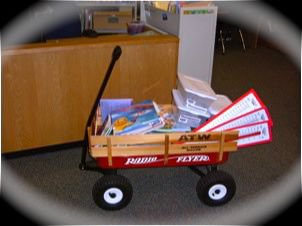 Reading Judi’s recent entry as well as the conversation on the AASL Forum about classroom collections, I decided it was time to revisit the red wagon I talked about in earlier postings. Someone once commented to me that the red wagon never went to a classroom when it wasn’t full. And this was true – the red wagon was a way for me to provide classrooms with “revolving collections” of materials that I knew would appeal to students as well as match the current curriculum goals in science or social studies for example. Many of my teachers had extensive classroom collections that they had amassed over the years. Their collections became wallpaper in the classroom and needed to be re-freshed. The library was the way to do this.
Reading Judi’s recent entry as well as the conversation on the AASL Forum about classroom collections, I decided it was time to revisit the red wagon I talked about in earlier postings. Someone once commented to me that the red wagon never went to a classroom when it wasn’t full. And this was true – the red wagon was a way for me to provide classrooms with “revolving collections” of materials that I knew would appeal to students as well as match the current curriculum goals in science or social studies for example. Many of my teachers had extensive classroom collections that they had amassed over the years. Their collections became wallpaper in the classroom and needed to be re-freshed. The library was the way to do this.
As I think about Judi’s post and the important point she makes about needing to come out of our silos and talk to each other, I think we need to see the desire for a classroom collection as a way for us to bridge the library and the classroom. Those teachers who have extensive classroom collections are often strong library allies. They collect books because they love them and they believe in putting books in the hands of kids. They have a bottomless need for books and reading and the library is their fix.
One of the best methods I observed for promoting reading in the classroom were genre baskets that changed regularly. One teacher I worked with submitted a new “red wagon request” every month to re-fresh her baskets with a variety of fiction genres, non-fiction, biography, and special formats like magazines or graphic novels.
I have to admit, I always got concerned when teachers asked for money from the budget to supply classroom collections. I had a principal who understood that scarce budgetary resources were best allocated to shared resources such as the library. One enterprising teacher, however, found a grant to purchase tubs and relatively inexpensive paperback book sets from a major publisher for every classroom. These tubs were also checked out from the library at the beginning of the year and returned at the end. A cursory inventory was done of each tub. Some loss was inevitable but we were able to add to these tubs with donations of paperbacks or duplicates that weren’t needed in the library collection.
I really appreciated the tone of Judi’s letter and think this open stance is our best approach to this issue. School librarians, teachers and principals want the same thing for our students when it comes to learning to read both critically and for sheer enjoyment. We want them to have access to a variety of appealing, quality materials. The materials in those tubs were pale compared with library books.
